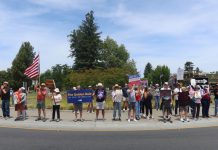Lack of housing, workers constraining level of growth during wildfire recovery
The further Sonoma County moves beyond the 2017 wildfires and all the economic losses and impacts of the natural disaster, the closer it may be getting to the next general recession.
As Sonoma County enters 2019, it is predicted the local economy will continue to be constrained by a housing shortage and related factors that will slow economic growth to a pace that might reach zero growth by year 2020.
In another observation offered by UCLA economist Jerry Nickelsburg at the county’s annual state of the economy breakfast, Sonoma County’s recent and current pace of recovery from the 2017 wildfires has been “very impressive.” The economist applauded local efforts to build thousands of new housing units and support higher worker wages across most industries. He said not to expect a recession over the next six months and reported the local economy is now better prepared for any future economic downturn than it was when the 2008 Great Recession hit.
Besides the lack of affordable worker housing and record low unemployment, Nickelsburg warned that “inconsistent national economic policies” could hasten the next recession, partly fueled by tariff battles, unpredictable immigration policies and international trade imbalances. Slowly rising interest rates may also slow the economy form its current 3.5 percent growth rate, the UCLA economist said.
The recent growth of the national, California and local economy has been partly boosted by a “sugar high from Republican federal tax cuts,” the economist said as he warned that next will come a “sugar crash.”
Still less than two years past the October 2017 wildfires, the local regional economy and local government spending is being more defined by disaster recovery activity than by larger California and national trends. Sonoma County Board of Supervisors chairman David Rabbitt (Second District) told the breakfast crowd of 600 business and government leaders that the “state of our county’s economy is strong.” He listed a long series of recovery and resiliency accomplishments that led to accelerated housing approvals and new construction work, infrastructure repairs, updated fire protection and disaster preparation planning and continued expansion of the SMART commuter train and increased county park acreage.
Economic Development Board executive director Ben Stone highlighted a list of similar accomplishments at each of the county’s nine incorporated cities, mainly focused around escalated housing construction. Rabbitt led a standing ovation for Stone, who will be retiring from his position in April after serving the county since 1986.
Nickelsburg has delivered the annual Sonoma County economic forecast for the past 10 years. Except for the years of 2008 and 2009, Nickelsburg has usually been able to present a positive economic forecast for the county, where the local economy almost always compared favorably against the rest of California and the nation.









